
Pope Clement II, was Pope from 25 December 1046 until his death in 1047. He was the first in a series of reform-minded popes from Germany.

Pope Clement III, born PaulinoScolari, reigned from 19 December 1187 to his death.
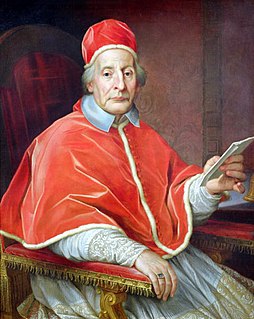
Pope Clement XII, born Lorenzo Corsini, was Pope from 12 July 1730 to his death in 1740.
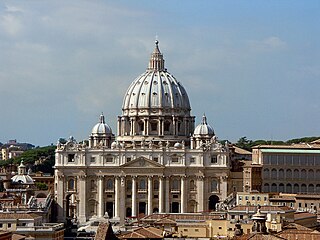
The Latin word basilica has three distinct applications in modern English. Originally, the word was used to refer to an ancient Roman public building, where courts were held, as well as serving other official and public functions. It usually had the door at one end and a slightly raised platform and an apse at the other, where the magistrate or other officials were seated. The basilica was centrally located in every Roman town, usually adjacent to the main forum. Subsequently, the basilica was not built near a forum but adjacent to a palace and was known as a "palace basilica".

Saint Lawrence or Laurence was one of the seven deacons of the city of Rome, Italy, under Pope Sixtus II who were martyred in the persecution of the Christians that the Roman Emperor Valerian ordered in 258.

The Cathedral of the Most Holy Savior and of Saints John the Baptist and the Evangelist in the Lateran, – also known as the Papal Archbasilica of St. John [in] Lateran, St. John Lateran, or the Lateran Basilica – is the cathedral church of Rome and serves as the seat of the Roman Pontiff.
In Judaism and Christianity, the concept of the Jubilee is a special year of remission of sins and universal pardon. In the Book of Leviticus, a Jubilee year is mentioned to occur every fiftieth year, during which slaves and prisoners would be freed, debts would be forgiven and the mercies of God would be particularly manifest.
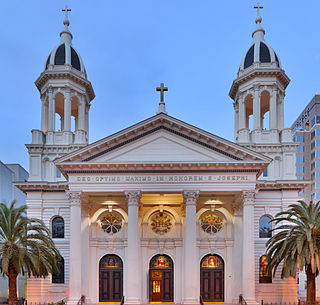
The Cathedral Basilica of St. Joseph is a large Roman Catholic church in Downtown San Jose, which serves as the cathedral for the Roman Catholic Diocese of San Jose in California, with the distinction of minor basilica.

Saint Rose of Lima, , was a member of the Third Order of Saint Dominic in Lima, Peru, who became known for both her life of severe asceticism and her care of the needy of the city through her own private efforts. A lay member of the Dominican Order, she was declared a saint by the Catholic Church, being the first person born in the Americas to be canonized as such.
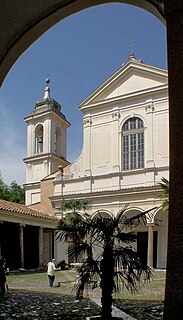
The Basilica of Saint Clement is a Roman Catholic minor basilica dedicated to Pope Clement I located in Rome, Italy. Archaeologically speaking, the structure is a three-tiered complex of buildings: (1) the present basilica built just before the year 1100 during the height of the Middle Ages; (2) beneath the present basilica is a 4th-century basilica that had been converted out of the home of a Roman nobleman, part of which had in the 1st century briefly served as an early church, and the basement of which had in the 2nd century briefly served as a mithraeum; (3) the home of the Roman nobleman had been built on the foundations of republican era villa and warehouse that had been destroyed in the Great Fire of 64 AD.

Santa Maria sopra Minerva is one of the major churches of the Roman Catholic Order of Preachers in Rome, Italy. The church's name derives from the fact that the first Christian church structure on the site was built directly over the ruins or foundations of a temple dedicated to the Egyptian goddess Isis, which had been erroneously ascribed to the Greco-Roman goddess Minerva.

The Basilica Papale di San Lorenzo fuori le Mura is a Roman Catholic Papal minor basilica and parish church, located in Rome, Italy. The Basilica is one of the Seven Pilgrim Churches of Rome and one of the five former "patriarchal basilicas", each of which was assigned to the care of a Latin Church patriarchate. The Basilica was assigned to the Patriarchate of Jerusalem. The Basilica is the shrine of the tomb of its namesake, Saint Lawrence, one of the first seven deacons of Rome who was martyred in 258. Many other saints and Bl. Pope Pius IX are also buried at the Basilica, which is the center of a large and ancient burial complex.

The Cathedral-Basilica of Saint Louis, King of France, also called St. Louis Cathedral, is the seat of the Roman Catholic Archdiocese of New Orleans and is the oldest cathedral in what would become the United States. The first church on the site was built in 1718; the third, built in 1789, was raised to cathedral rank in 1793. The cathedral was expanded and largely rebuilt in 1850, with little of the 1789 structure remaining.
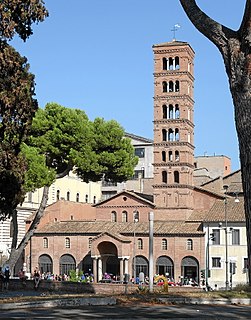
The Basilica of Saint Mary in Cosmedin is a minor basilica church in Rome, Italy. It is located in the rione of Ripa.
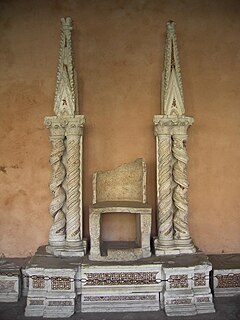
A major basilica is one of the four highest-ranking Roman Catholic church buildings, all of which are also papal basilicas: the Archbasilica of St. John Lateran, St. Peter's Basilica, the Basilica of St. Paul Outside the Walls, and the Basilica di Santa Maria Maggiore. All of them are located within the diocese of Rome: St. Peter's Basilica is located in Vatican City and thus within the territory and sovereign jurisdiction of the Holy See. The other three are geographically located in Italian territory, but enjoy extraterritorial status under the Lateran Treaty. The Archbasilica of St. John in the Lateran is the seat of the Pope and the site of the Papal Cathedra, and is the oldest and first in rank of the major basilicas.
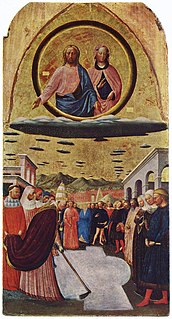
The Dedication of the Basilica of St Mary Major is a feast day in the General Roman Calendar, optionally celebrated annually on 5 August with the rank of memorial.

Roman Marian churches are religious buildings dedicated to the veneration of the Blessed Virgin Mary. These churches were built throughout the history of the Catholic Church, and today they can be found on every continent including Antarctica. The history of Marian church architecture tells the unfolding story of the development of Roman Catholic Mariology.

The Basilica of St. Thérèse of Lisieux is a Roman Catholic church and minor basilica dedicated to Saint Thérèse of Lisieux. Located in Lisieux, France, the large basilica can accommodate 4,000 people, and, with more than two million visitors a year, is the second largest pilgrimage site in France, after Lourdes. Pope John Paul II visited the Basilica on 2 June 1980.
The following is a timeline of the history of the city of Rome, Italy.























